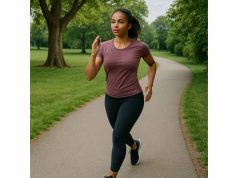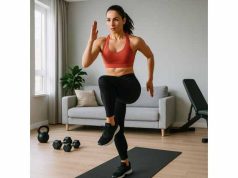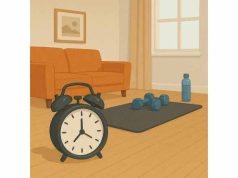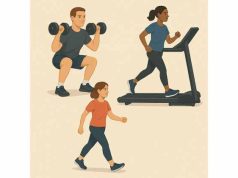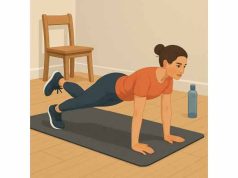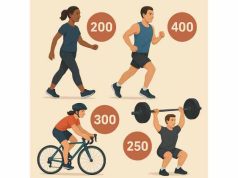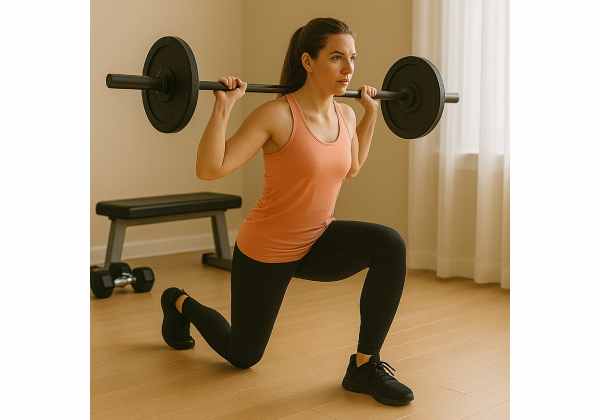
Strong glutes and legs do more than shape how you look. They drive everyday movement, protect joints, and raise the number of calories you burn inside and outside the gym. Trained well, your lower body becomes a “metabolic engine” that helps you maintain a calorie deficit without feeling worn down. In this guide you will learn why lower-body training matters for fat loss, the best exercises to prioritize, and how to program sets, reps, and weekly plans for home or gym. We will also cover technique cues, common mistakes, joint-friendly options, and recovery. For the bigger picture that blends strength, cardio, and steps into a coherent plan, see our overview of evidence-based exercise for losing body fat and then apply the templates below.
Table of Contents
- Why train glutes and legs
- Best lower-body exercises
- How to program workouts
- Home vs. gym templates
- Technique cues and mistakes
- Joint-friendly options
- Nutrition, recovery and tracking
- Frequently Asked Questions
Why train glutes and legs
Lower-body muscles are large and highly active in daily life. Training them increases the energy you use during the session, but the bigger return is what happens afterward: you keep more lean tissue while dieting, your non-exercise movement (steps, posture, fidgeting) tends to rise because you feel better, and your capacity for other calorie-burning work—walking, cycling, hill repeats—improves. That multiplier effect is why glute and leg work is central in effective fat-loss plans.
Benefits that matter during a cut
- Muscle retention. Your body prefers to shed tissue it does not use. Regular lower-body strength work signals your legs and glutes are essential, so more of the weight you lose is fat, not muscle.
- Higher session density. Compound lifts recruit many muscles at once. When you organize them in pairs or short circuits, the cardiovascular system works hard while you lift—efficient for busy schedules.
- Movement capacity. Stronger legs make hills, stairs, and long walks easier, so you accumulate more weekly activity with less fatigue.
How often should you train legs for fat loss?
Most lifters do well with 2 focused lower-body sessions per week, or 2 full-body sessions where lower-body work leads. Add 1–2 short conditioning days (steps, bike, incline treadmill) to support the calorie deficit. Keep at least one true rest day weekly.
Intensity and effort
Muscle responds to effort as much as load. For most sets, aim to finish with 1–3 reps in reserve (RIR)—challenging, but with technique intact. This preserves joints and still sends a strong “keep this muscle” signal while dieting.
Expectations and progress
During a fat-loss phase you should not chase constant personal records. Progress often looks like holding similar loads and reps while your body weight trends down, or improving tempo and range of motion. Be patient and track performance honestly.
The big picture
Training determines what you keep; nutrition determines what you lose. Pair your program with realistic habits and safe pacing. For a refresher on sustainable rates of loss, portion anchors, and behavior targets, see our concise guide to healthy weight-loss basics.
Best lower-body exercises
Choose movements that are stable, scalable, and easy to load. You do not need dozens of variations—just a few patterns executed well: a squat, a hinge, a unilateral movement, and a hip-dominant thrust or bridge. Add calves and trunk work as needed.
1) Squat pattern
- Options: goblet squat, front squat, back squat, leg press.
- Why it helps: trains quads, glutes, and core; raises heart rate quickly when organized in pairs.
- Coaching cue: “knees forward, hips down,” keep whole foot planted, ribs stacked over pelvis.
2) Hinge pattern
- Options: Romanian deadlift (RDL), kettlebell deadlift, trap-bar deadlift, hip hinge with dumbbells.
- Why it helps: loads posterior chain (glutes, hamstrings, back extensors) for powerful calorie-dense work.
- Cue: push hips back, soft knees, spine long; imagine closing a car door with your glutes.
3) Unilateral (single-leg)
- Options: split squat, reverse lunge, step-up, Bulgarian split squat.
- Why it helps: balances sides, challenges hips for stability, and keeps effort high with moderate loads.
- Cue: front knee tracks over toes; stay tall; drive through midfoot.
4) Hip thrust/bridge
- Options: barbell hip thrust, dumbbell or banded hip thrust, glute bridge on floor.
- Why it helps: isolates glutes with minimal spine load; easy to progress by small load jumps or pauses.
- Cue: chin tucked, ribs down, squeeze glutes to full lockout without over-arching.
5) Hamstring curl (knee flexion)
- Options: machine curl, Swiss-ball curl, slider curl, Nordic regression.
- Why it helps: complements hinge work; improves knee comfort and sprint stability.
6) Calves and adductors
- Options: standing/seated calf raises; Copenhagen plank or adductor machine.
- Why it helps: ankle strength improves walking and running economy; strong adductors support knee health.
7) Carries and trunk
- Options: farmer carry, suitcase carry, plank variations.
- Why it helps: builds bracing capacity that transfers to every lower-body lift and keeps heart rate elevated.
How to choose your mix
For each workout, select one squat, one hinge or hip thrust, one single-leg, then one accessory (curl, calf, or trunk). Rotate variations every 4–6 weeks to keep progress moving without constant novelty. If you are new to strength training and want an all-round weekly structure, our beginner strength plan shows how to balance lower- and upper-body work during a cut.
How to program workouts
A good fat-loss program is simple to follow, repeatable when life gets busy, and flexible enough to adjust for recovery. Use these guidelines to set volume, intensity, and frequency.
Sets and reps
- Main lifts (squat/hinge/thrust): 3–4 sets of 5–10 reps. Choose loads that leave 1–3 reps in reserve.
- Single-leg work: 2–4 sets of 6–12 reps per side.
- Accessories (curl, calves, trunk): 2–3 sets of 10–15 reps, or timed holds (30–60 seconds).
Rest periods
- Main lifts: 90–150 seconds between sets for quality output.
- Single-leg and accessory: 60–90 seconds.
Shorter rests raise heart rate, but do not sacrifice technique. You will burn more across the week by lifting well and then walking more, rather than turning every set into cardio.
Weekly frequency
- Option A (full-body x3): two days emphasize lower-body, one day lighter legs plus upper-body.
- Option B (upper/lower x4): two lower-body days, two upper-body days—ideal if you recover well.
- Option C (full-body x2): pair with extra steps and one short conditioning session during aggressive deficits.
Pairing and density
Use paired sets to keep sessions efficient: alternate a squat set with a hamstring curl; alternate hip thrusts with a plank. You rest the primary mover while keeping the session moving. For metabolic density, finish with a 6–8 minute “carry and step-up” block at steady pace.
Progression
Change only one variable at a time. Across 4–6 weeks you can:
- Add one set to a main lift, or
- Add 2.5–5% load while keeping reps and RIR, or
- Add one rep per set within the target range, or
- Add a 1–2 second pause in the hardest range (e.g., bottom of squat).
Conditioning around leg days
Keep hard intervals away from your heaviest lower-body day. Use Zone 2 cardio (brisk walking, light cycling) after strength or on separate days to raise weekly burn without draining recovery. Unsure how many off days you need? See our practical guide to scheduling rest to avoid stalling.
Deloads
Every 4–6 weeks, reduce volume by ~30% for one week. Dieting narrows recovery margins; a short reset preserves momentum.
Home vs. gym templates
You can build strong glutes and legs with minimal tools. The key is exercise selection, tempo control, and smart pairing. Choose the setup you will use consistently.
At home: bodyweight or dumbbells (30–40 minutes)
- Warm-up (5–6 minutes): brisk steps, hip airplanes, squat to stand, glute bridge ×10.
- Block A (3 rounds): Goblet squat 8–10 (3–1–1 tempo) → Half-kneeling hip flexor stretch 20–30″.
- Block B (3 rounds): Romanian deadlift with dumbbells 10–12 → Side plank 30–45″/side.
- Block C (2–3 rounds): Reverse lunge 8–10/side → Glute bridge 12–15 (2-second squeeze).
- Finisher (optional 5 minutes): Step-ups 10/side + suitcase carry 20–30 m, repeat steady.
If you use dumbbells and want a full-body progression that pairs well with weight loss, our dumbbell program offers set-by-set templates.
In the gym: machines plus free weights (40–50 minutes)
- Warm-up: 5 minutes easy bike; hip hinge drill; practice sets.
- Main 1: Front squat or leg press 3–4×6–8 (2–3 min rest).
- Main 2: Romanian deadlift or trap-bar deadlift 3–4×6–8.
- Assistance: Hip thrust 3×8–12 (1–2 sec pause at top).
- Unilateral: Walking lunge or split squat 2–3×8–10/side.
- Accessories: Seated leg curl 2–3×10–15; standing calf raise 2–3×10–15; plank 2×45–60″.
Busy-day circuit (20–25 minutes)
Perform 3 rounds at a calm pace:
- Goblet squat 10–12
- Step-up 8–10/side
- Hip hinge 12
- Glute bridge 15 with 2-second squeeze
Rest 60–75 seconds between rounds. For very tight schedules, borrow structures from our 30-minute templates and slot in your preferred leg moves.
Tempo and range
Use slow lowers (2–3 seconds) and controlled pauses in positions where you are weakest. This increases stimulus without chasing heavier loads when dieting.
Technique cues and mistakes
Form keeps output high and joints happy. Use these concise cues and avoid common errors that waste effort during a cut.
Universal cues
- Stack: ribs over pelvis; brace lightly as if preparing to exhale through a straw.
- Feet: full-foot pressure; big toe, little toe, and heel share the load.
- Path: knees track over second/third toes; shins and torso share the movement in squats.
- Speed: control the lower (2–3 seconds), move up with intent.
Squat mistakes
- Butt wink from early pelvic tuck: improve depth gradually; elevate heels on small plates; brace before descent.
- Heels lifting: widen stance slightly; use a goblet hold to counterbalance.
- Collapse inward (valgus): think “press the floor apart”; strengthen glute med with side steps.
Hinge mistakes
- Rounding low back: soften knees, push hips back, keep weights close to thighs.
- Shrugging: keep shoulders packed; think “armpits in pockets.”
- Too much knee bend: if it looks like a squat, decrease knee flexion and feel the hamstrings stretch.
Single-leg mistakes
- Wobbling torso: shorten stance and slow down; hold a weight goblet-style for counterbalance.
- Front heel lifting: shift pressure midfoot-heel; use a slight forward torso lean.
Hip thrust mistakes
- Over-arching at lockout: ribs down; tuck pelvis slightly; pause and squeeze.
- Neck strain: keep chin tucked and look ahead, not up.
A crisp, consistent warm-up supports quality reps. For a short routine that covers ankles, hips, and bracing, see our practical guide to warm-up and recovery.
Joint-friendly options
Sensitive knees, hips, or backs do not disqualify you from effective leg training. Adjust exercise choices, ranges, and tempos so the stimulus lands on muscle, not irritated tissues.
If knees are cranky
- Prefer supported split squats, leg press with a controlled depth, box squats, or step-ups to a lower box.
- Keep shins closer to vertical early on; increase knee travel only as comfort allows.
- Use slow eccentrics (3–4 seconds) and a 1–2 second pause at the bottom to build tolerance without heavy loads.
If hips or low back are sensitive
- Choose hip thrusts/bridges, goblet squats, hinge to blocks (elevate weights to reduce range), and sled pushes if available.
- For hinges, keep the load closer to your body and stop when the spine wants to round.
Low-impact conditioning pairings
- On non-lifting days, use incline treadmill walking, bike, or elliptical to lift weekly burn without joint stress. Our overview of joint-friendly cardio options lists simple progressions.
Bands and isometrics
- Add loop-band lateral steps, band-resisted bridges, and isometric wall sits (20–45 seconds) to create strong local fatigue when heavy loading is not appropriate.
Range and depth
- Pain-free range is the right range. Aim to increase depth gradually over weeks, not within one workout. Document where you start so you can see progress clearly.
Nutrition, recovery and tracking
Lower-body training protects muscle while you diet. Nutrition and recovery choices determine how good you feel and how well you perform.
Protein and calories
- Target 1.6–2.2 g/kg/day of protein spread across 3–4 meals.
- Keep a modest calorie deficit (often 300–500 kcal/day for many adults). Aggressive deficits invite fatigue and stall training.
Carbohydrates and timing
- Place a carb-protein meal within 2–3 hours before leg sessions to support output (e.g., yogurt and fruit; rice and eggs).
- After training, eat protein + fiber-rich carbs to support recovery and appetite control.
Sleep and stress
- Aim for 7–9 hours. Poor sleep increases hunger and lowers training quality.
- Keep at least one full rest day weekly; deload every 4–6 weeks by trimming volume ~30%.
Cardio that complements legs
- Use Zone 2 on non-leg days or after lighter work. Save HIIT for days away from heavy squats/hinges to protect performance.
Simple progress checks
- Performance: loads, reps, or tempo at similar RIR.
- Body measures: weekly average weight (3 morning weigh-ins), waist/hip every two weeks, monthly photos.
- Behavior: sessions completed, total minutes lifted, and daily steps.
When fat loss stalls (adjust one thing for 10–14 days)
- Add one set to a main lower-body lift or 5 minutes of Zone 2.
- Trim ~200 kcal/day from calorie-dense extras; keep protein steady.
- Increase daily steps by 1,500–2,500.
- Insert a deload if fatigue, soreness, and sleep worsen.
Frequently Asked Questions
Will training glutes and legs make my legs look bigger while I’m losing weight?
During a calorie deficit, strength work mainly helps you keep existing muscle, not add large amounts. Early “tightness” is often reduced water and better muscle tone. Over weeks, legs typically look smaller and more defined as body fat drops.
How many leg days should I do for fat loss?
Most people progress well with two focused lower-body sessions or two full-body sessions where legs lead. Add one to two cardio or step-focused days. Keep at least one rest day. Quality and consistency matter more than squeezing in a third heavy day.
Are high reps better than heavy weights for burning fat?
Both can work when effort is high and technique is solid. Use moderate rep ranges (5–12) for main lifts and 10–15 for accessories. Prioritize sets that end with 1–3 reps in reserve. This protects joints and preserves muscle during a deficit.
Can I lose fat with bodyweight leg workouts only?
Yes—if you train close to challenge using tempo, pauses, and single-leg variations. Progress by increasing reps, slowing the lower, adding pauses, or elevating your rear foot for split squats. If available, add a backpack or dumbbells for steady progression.
Should I do cardio before or after leg day?
Do strength first when both occur in one session, then finish with easy cardio. Better yet, separate hard cardio and heavy leg training by at least six hours or place them on different days. This preserves lifting quality and recovery.
How long until I see results in my legs and glutes?
Most notice changes in strength and firmness within 3–4 weeks and visible shape changes by 6–10 weeks, assuming consistent training, a modest calorie deficit, and adequate protein and sleep. Photos and measurements reveal progress better than a single scale reading.
References
- Resistance training effectiveness on body composition and body weight outcomes in individuals with overweight and obesity across the lifespan: A systematic review and meta-analysis 2022 (Systematic Review & Meta-analysis)
- Compatibility of Concurrent Aerobic and Strength Training for Skeletal Muscle Size and Function: An Updated Systematic Review and Meta-Analysis 2022 (Systematic Review & Meta-analysis)
- The Effects of Concurrent Aerobic and Strength Training on Muscle Fiber Hypertrophy: A Systematic Review and Meta-Analysis 2022 (Systematic Review & Meta-Analysis)
- The effect of protein intake on athletic performance: a systematic review and meta-analysis 2024 (Systematic Review & Meta-analysis)
- A systematic review, meta-analysis and meta-regression of the effect of protein supplementation on resistance training-induced gains in muscle mass and strength in healthy adults 2018 (Systematic Review & Meta-analysis)
Medical Disclaimer
This content is educational and does not replace personalized medical advice. Speak with a qualified professional before changing your exercise or nutrition plan—especially if you have cardiovascular, metabolic, or orthopedic conditions; take medications that affect heart rate or balance; are pregnant or postpartum; or are returning after injury or surgery.
Share and Stay Connected
If this guide helped you plan your glute and leg training, please share it with someone who would benefit and follow us on your preferred platform. Your support enables us to continue producing clear, evidence-informed resources.

